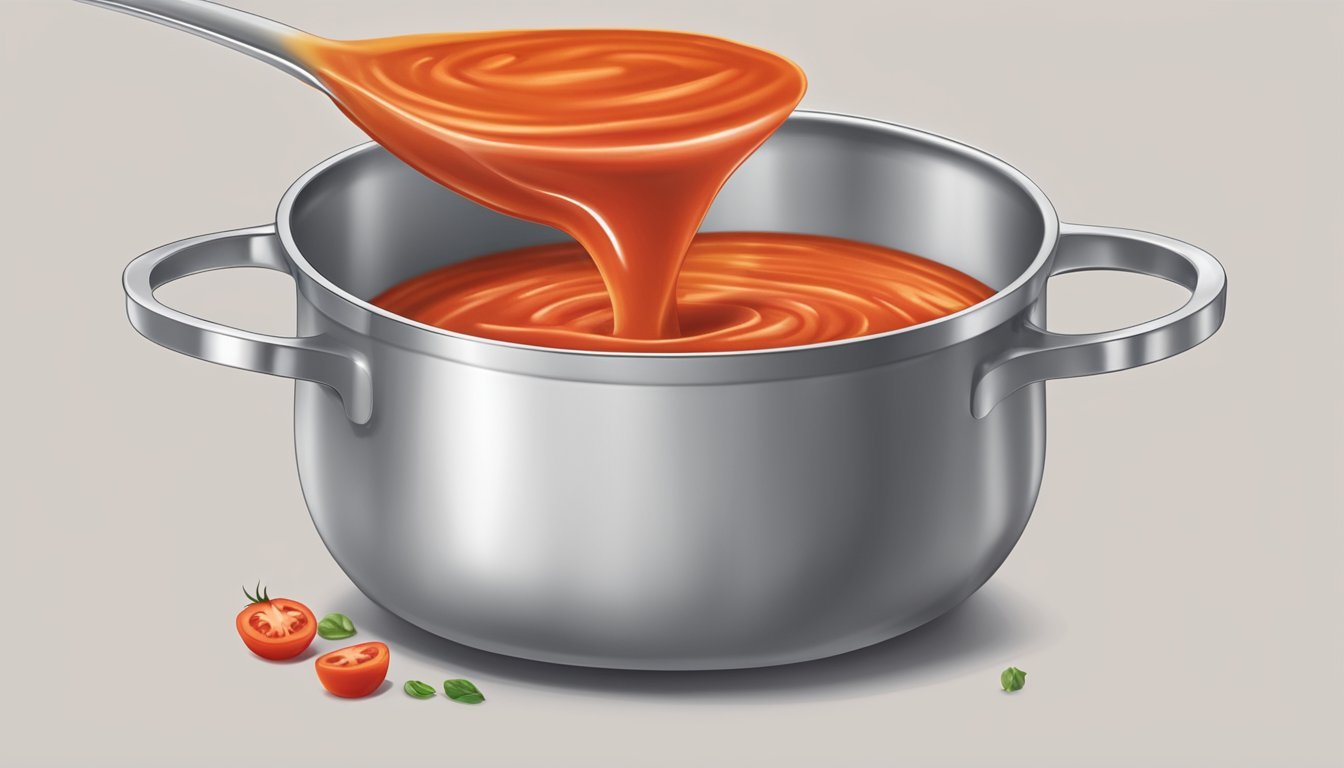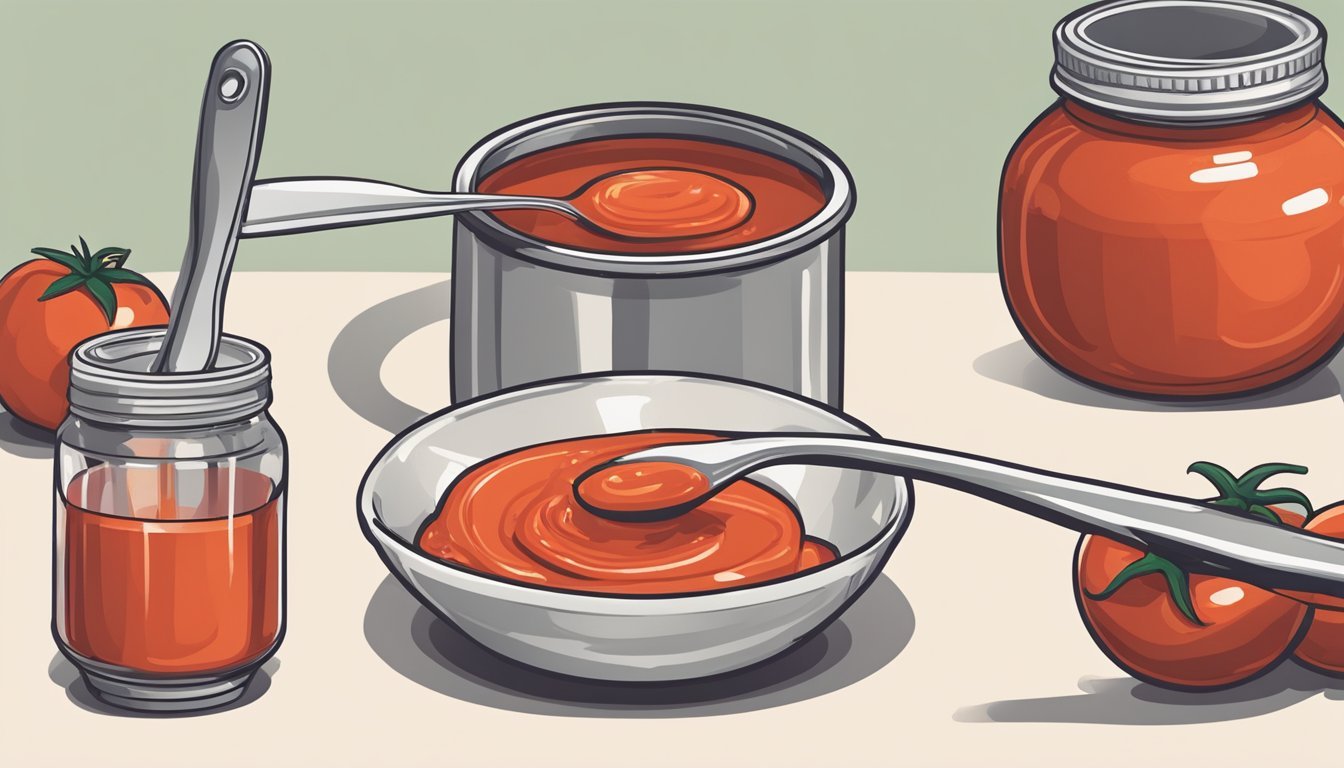How to Substitute Tomato Sauce for Tomato Paste
Easy Conversion Guide
In the culinary world, tomato paste is a staple ingredient, valued for its thick consistency and concentrated tomato flavor. It serves as a foundation in a variety of sauces, soups, and stews. However, in situations where tomato paste is unavailable, cooks can successfully use tomato sauce as an alternative. Despite tomato sauce being thinner and less concentrated, it can be transformed to mimic the qualities of tomato paste with the correct techniques.
Substituting tomato sauce for tomato paste involves more than just a one-to-one conversion. To achieve the desired thickness and flavor concentration similar to tomato paste, tomato sauce typically needs to be reduced. This reduction process is critical; it involves simmering the tomato sauce over heat until it loses a good portion of its water content, allowing the flavors to deepen and the sauce to reach an appropriate consistency for recipes that require tomato paste.
One of the main considerations when replacing tomato paste with tomato sauce is understanding the ratio and adjustments needed to ensure that the dish maintains its intended taste and texture. The advice found in cooking resources suggests a starting ratio where a combination of reduced tomato sauce can substitute for tomato paste in recipes, ensuring that the culinary creation retains its authentic flavor profile without being watered down.
Understanding Tomato Paste and Sauce
In this section, readers will gain a clear understanding of tomato paste and sauce, their unique characteristics, and how they differ in use and composition.
The Basics of Tomato Paste and Tomato Sauce
Tomato paste is a highly concentrated product made by cooking down tomatoes to remove most of the water content. It's known for its thick consistency and intense tomato flavor, often used in smaller quantities to enhance the taste of dishes. Tomato sauce, on the other hand, is thinner, less concentrated, and may include additional seasonings. It's commonly used as a base in various recipes.
Comparing Consistencies and Textures
Consistency: Tomato paste is much thicker than tomato sauce. This thickness is what helps thicken stews and casseroles (What wine goes well with casseroles?). Tomato sauce's consistency is more fluid, making it suitable for soups and pasta dishes.
Texture: The texture of tomato paste is smooth and dense, whereas tomato sauce tends to be lighter with a more liquid texture.
Differences in Cooking Applications
Tomato paste is typically used to deepen flavors in recipes such as stews, soups, and casseroles, requiring less volume due to its concentrated nature. Tomato sauce is used more generously and is a staple for pasta and pizza, providing a ready-to-use tomato base that complements other ingredients without overwhelming them.
Nutritional Variations
Both tomato paste and tomato sauce provide essential nutrients, including vitamins A and C. However, tomato paste often has more calories and nutrients per ounce due to its concentrated form. Tomato sauces might contain additives such as sugar and salt, affecting their nutritional profile.
Shelf Life and Storage
Pantry: Unopened jars of tomato paste and sauce can be stored in the pantry. Tomato paste will typically have a longer shelf life due to its lower moisture content.
Refrigerator: Once opened, both should be kept in the refrigerator. Tomato sauce will last about a week, while paste may last up to two weeks.
Freezer: Both can be frozen to extend shelf life—tomato paste in ice cube trays for easy portioning, and tomato sauce in freezer-safe bags or containers.
Substituting Tomato Sauce for Tomato Paste
In the culinary arts, knowing how to accurately substitute tomato sauce for tomato paste is essential for maintaining flavor and consistency in recipes. This section will guide readers through proper conversion ratios, flavor adjustments, consistency alterations, and the addition of herbs and spices to best replicate tomato paste with tomato sauce.
Conversion Ratios for Substitution
To replace tomato paste with tomato sauce, a basic 3:1 ratio is recommended. For every tablespoon of tomato paste needed, one can use three tablespoons of tomato sauce. This compensates for the difference in concentration and water content.
Adjusting Flavor and Sweetness
Tomato paste possesses a deep, concentrated tomato flavor that is less sweet compared to tomato sauce. To adjust for this, reduce added sugars in the recipe, if any, or one can add a pinch of salt to counteract the sweetness of the tomato sauce.
Altering Thickness and Consistency
Tomato sauce is more fluid than tomato paste, thus it may need to be thickened to match the consistency desired in recipes. This can be achieved by simmering the tomato sauce to cook down the liquid and thicken it. Alternatively, one can use a thickening agent such as cornstarch or flour:
Cornstarch: Mix 1 teaspoon of cornstarch with 2 teaspoons of water for every cup of tomato sauce.
Flour: Whisk 2 tablespoons of flour into the sauce for every cup, cooking it to remove the raw flavor.
Complementary Herbs and Spices
Tomato paste is often used in recipes that benefit from its rich flavor, enhanced by the addition of herbs and spices. When substituting with tomato sauce, one may add basil, oregano, garlic, or paprika to achieve a similar taste profile.
DIY Tomato Paste from Tomato Sauce
One can create a homemade tomato paste equivalent by further reducing the sauce. Use a blender or food processor to smooth the sauce if necessary. Then, simmer it over medium heat until the consistency resembles that of tomato paste. The key is to achieve a thick, rich texture without burning the sauce.
Using Substitutes in Recipes
Integrating tomato sauce as a substitute for tomato paste requires adjusting ratios and cooking methods to fit various recipes effectively.
Substitutes for Tomato Paste in Italian Dishes
Italian cuisine often relies on the concentrated flavor of tomato paste to create rich, deep flavors in dishes such as pasta, marinara sauce, and pizza sauce. When using tomato sauce as a substitute, one should opt for a reduced version. To replicate the intensity of tomato paste in Italian recipes, reduce the tomato sauce by simmering over low heat, allowing excess water to evaporate until thick. A general guideline is to reduce by half to achieve a consistency resembling paste.
Alternative Substitutes for Tomato Paste
Other than tomato sauce, there are additional substitutes suitable for replacing tomato paste. Ketchup can serve as a convenient substitute with its similar texture and tanginess, applying a 1:1 ratio for smaller quantities. Alternatively, a combination of canned tomatoes, finely diced or pureed, and reduced can mimic the concentrated essence of tomato paste. Incorporating fresh tomatoes requires cooking down and straining to remove skins and seeds for a smoother concentrate.
Adjusting Recipes for Tomato Sauce
When substituting tomato sauce into recipes calling for tomato paste, the moisture content must be considered. Using three times the amount of tomato sauce to replace tomato paste could result in a thinner, less robust dish. To counteract this, one might need to either reduce other liquids in the recipe or simmer the dish for a longer period to achieve the desired consistency and concentration of flavor without diluting the dish's character.
Creative Variations with Tomato Sauce Substitutes
While traditional recipes prescribe specific ingredients, introducing tomato sauce as a tomato paste substitute opens a door to creativity. In stews, chili, and casseroles, the sweet and tangy profile of tomato sauce can be enhanced with additional seasonings. Red peppers, stewed or crushed tomatoes, and even a dash of juice can lend the sauce an enriched savor.
Health Considerations and Dietary Restrictions
When substituting tomato sauce for tomato paste, individuals must consider the added sugar and sodium in tomato sauce, as well as its suitability for various dietary restrictions such as vegan or vegetarian diets, and potential allergens.
Reducing Sugar and Sodium
Tomato sauce typically contains more sugar and sodium than tomato paste. To reduce these levels, one can:
Opt for low-sodium or no-salt-added tomato sauce variants to control salt intake.
Choose tomato sauces with no added sugars or make homemade sauce to minimize sugar content.
It is essential to read the nutrition labels to make an informed choice that aligns with dietary goals.
Vegan and Vegetarian Options
For those following a vegan or vegetarian diet:
Ensure that the tomato sauce does not contain any animal-based ingredients. Some sauces may include cheeses or meat flavors.
Opt for tomato sauces that are certified vegan or have a clear ingredient list that aligns with vegan or vegetarian requirements.
Allergens and Sensitivities
Tomato sauces may contain allergens or ingredients that cause sensitivities, such as:
Onions and garlic, which can be problematic for those with IBS or FODMAP sensitivities.
Spices that could trigger allergies or intolerances.
Choosing a simple tomato sauce with minimal ingredients or making a homemade sauce allows for better control over the content, catering to specific health needs.
Storage and Preservation
When substituting tomato sauce for tomato paste, proper storage and preservation methods ensure maximum shelf life and retain the desired consistency. These techniques are crucial in preventing spoilage and maintaining the quality of both store-bought and homemade substitutes.
Extending the Shelf Life of Homemade Substitutes
Homemade tomato sauce can be preserved longer by storing it in an airtight container and keeping it in the refrigerator, where it will stay fresh for up to one week. For enhanced longevity, adding a thin layer of olive oil on top before sealing can act as a barrier against bacteria.
Freezing and Thawing Techniques
To preserve homemade tomato sauce for several months, freeze it in small portions. Use freezer bags or containers, leaving some space for expansion. To thaw, transfer the sauce to the refrigerator overnight or reheat gently, stirring to maintain consistency.
Canning Homemade Tomato Sauce
Canning is an effective method to store homemade tomato sauce for up to a year. Sterilize your jars, fill them with hot sauce, leaving about ½ inch headspace, and process them in a boiling water bath. Ensure the lids seal properly to create a vacuum, which firmly preserves the sauce.
Tips for Storing Opened Tomato Sauce
Once a jar of tomato sauce is opened, it should be stored in the refrigerator to prevent spoilage. The sauce will last up to a week if kept chilled. Transfer the sauce to a glass or plastic airtight container to further extend its shelf life and maintain its flavor and consistency.




